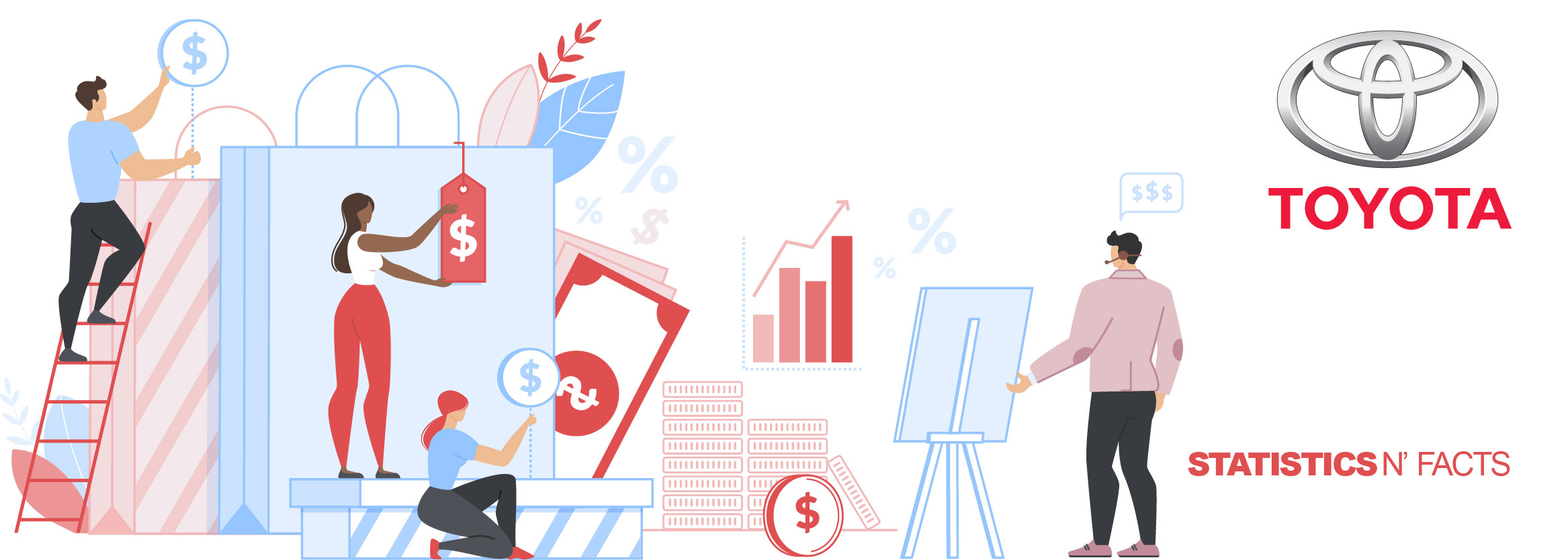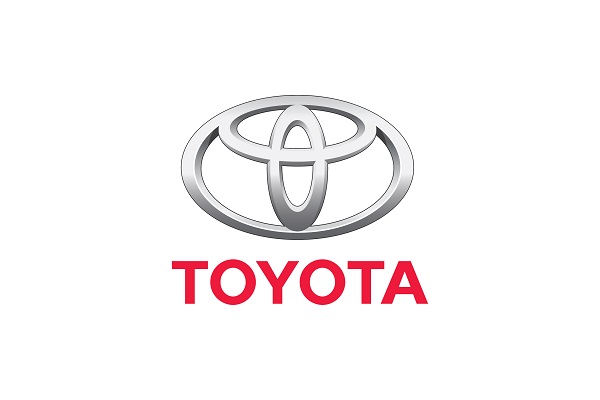Toyota Motor Statistics: Toyota Motor Corporation is into designing, manufacturing, assembling, and sales of passenger vehicles, commercial vehicles and minivans, and related accessories. It operates mainly through the Automotive and Financial Services segments.
Products and Services
The company offers conventional engine vehicles, including compact and subcompact cars under the names Corolla, Vitz, Yaris, Passo, Aqua, Roomy, Etios, Tank, Prius C, AGYA, Rush, Daihatsu, and Yaris iA; hybrid cars under Prius, C-HR, Camry, Avalon, Crown, UX, Prius PHV, Corolla SD, and WG HV names; and fuel cell vehicles under brand names SORA and MIRAI. Toyota Motor Corporation also provides mid-size cars under brand names Camry and REIZ; luxury cars under Avalon, Lexus, Crown, and Century limousines; sports cars under the LC and Supra names; and sport-utility vehicles under the Sequoia, RAV4, Land Cruiser, and Highlander brand names. In addition, the company offers pickup trucks under Tacoma and Tundra names; minivans under the Alphard, Noah/Voxy, Calya, Estima, Sienta, and Sienna brand names; and trucks and buses.
Furthermore, Toyota Motor Corporation provides financial services such as retail financing and leasing, wholesale financing, insurance, and credit cards; and manufactures and sells prefabricated housing. In addition, the company engages in information technology-related businesses, comprising the operation of a Web portal for automobile information known as GAZOO.com.
History
1924: Toyoda Model G Automatic Loom was invented.
1929: Automatic-loom patent was sold to a British company.
1930: Kiichiro Toyoda started research into a small gasoline-powered engine.
1933: Automobile Department was established in Toyoda Automatic Loom Works, Ltd.
1935: “Five Main Principles of Toyoda” was compiled, and these include: Always be faithful to your duties, thereby contributing to the Company and to the overall good; Always be studious and creative, striving to stay ahead of the times; Always be practical and avoid frivolousness; Always strive to build a homelike atmosphere at work that is warm and friendly; Always have respect for spiritual matters, and remember to be grateful at all times.
1936: The AA Sedan was completed.
1937: Toyota Motor Co., Ltd. was established.
1938: Honsha Plant started production.
1950: Company faced a financial crisis, so Toyota Motor Sales Co., Ltd. was established.
1951: Suggestion System started.
1955: The Toyopet Crown, the first full-fledged passenger car, was launched.
1957: The first prototypes of the Crown were exported and USA Toyota Motor Sales, U.S.A., Inc. was established the same year.
1959: Motomachi Plant started production (the first passenger car plant in Japan).
1975: The prefabricated housing business started.
1982: Toyota Motor Co., Ltd., and Toyota Motor Sales Co., Ltd. merged into Toyota Motor Corporation.
1988: Toyota Motor Manufacturing, Kentucky, Inc. started production.
1989: The Lexus brand – the luxury arm of Toyota – was launched in the US.
1992: Toyota Motor Manufacturing (UK) Ltd. started production.
1997: The Prius, the world’s first mass-produced hybrid car, was launched.
1999: Cumulative domestic production exceeded 100 million vehicles.
2000: Sichuan FAW Toyota Motor Co., Ltd. started production in China.
2002: Tianjin FAW Toyota Motor Co., Ltd. started production in China.
2006: GAC Toyota Motor Co., Ltd. started production in China.
2012: The Prius PHV was launched and cumulative worldwide production exceeded 200 million vehicles.
2014: The Mirai, the world’s first publicly-marketed fuel cell car, was launched.
2017: Cumulative worldwide sales of hybrid vehicles exceeded 10 million.
2018: Toyota introduced the Toyota Prius Plug-in with oil cell technology, a new hybrid-electric demonstrator vehicle.
2019: Toyota Motor entered into a joint venture agreement with Denso Corporation to develop next-generation in-vehicle semiconductors.
2020: Toyota Kirloskar Motor launched MPV Vellfire in India.
Strategy
- Toyota focuses on producing reliable vehicles and ensuring the sustainable development of society through innovation and the provision of high-quality products and services.
- Toyota plans to develop newer forms of transportation such as automated driving and pursue new ways of connecting technology with people.
- Toyota is analyzing and processing the big data generated by cars to create information that is useful for customers and a variety of connected services.
- As a part of introducing innovative manufacturing practices, Toyota has come up with the “Toyota Production System (TPS)”. TPS intends to completely eliminate waste in order to improve productivity within the flow of things.
- As a part of the Toyota Environmental Challenge 2050, launched in 2015, Toyota aims to reduce its global average new-vehicle CO2 emissions 2050 by 90%, compared with the 2010 level.
Recent News
- In July 2019, NEDO, Sharp Corporation (Sharp), and Toyota Motor Corporation (Toyota) announced a plan to commence public road trials in order to assess the effectiveness of improvements in cruising range and fuel efficiency of electrified vehicles.
- In July 2019, Toyota Motor Corporation (Toyota) announced its decision to expand its KINTO ONE “beloved car” subscription service nationwide, which was started on a trial basis in the Tokyo area.
- In July 2019, TOYOTA GAZOO Racing confirmed that it will launch the GR Supra GT4, which is a race car for customer teams, next year (2020). TOYOTA GAZOO Racing intends to strengthen its focus on customer motorsports in order to enable motorsports lovers around the world to freely participate in races and to develop ever-better cars.
- In July 2019, Lexus unveiled its plan to expand its exquisite LC flagship coupe range, with confirmation that a dramatically styled open-top version is to go into production in the near future.
- In June 2019, Toyota and Subaru agreed to bring together their cultivated technologies, for the joint development of a Battery Electric Vehicle-dedicated platform (for midsize and large passenger vehicles).
- In May 2019, Lexus unveiled the new 2020 RX luxury SUV, revealing evolutionary changes to the brand’s core model.
- In July 2020, due to the outbreak of the COVID-19 crisis, a few small and medium-sized businesses particularly are facing a problem, Toyota Motor North America (TMNA) along with its Pan-Asian non-profit partners, is supporting a variety of initiatives aimed at helping Asian American-Pacific Islander (AAPI) entrepreneurs sustain their companies.
- In August 2020, Toyota and Honda started demonstration testing of a mobile power generation/output system that delivers a secure supply of electricity in times of disaster in the future. The Moving e mobile power generation/output system will consist of Honda’s Power Exporter 9000 portable external power output device, Toyota’s CHARGING STATION fuel cell bus, and Two types of Honda’s portable batteries: LiB-AID E500 and Honda Mobile Power Pack (MPP), and Honda Mobile Power Pack Charge & Supply Concept charger/discharger for MPP.
- In August 2020, Toyota showcased out all-new Yaris cross in Japan with a hybrid electric vehicle (HEV) system that enables the Yaris to achieve a better level of fuel economy for its class.
- In August 2020, Toyota’s Global Sales and Production recover to 90% of last year’s level in July 2020.
- In August 2020, The Japan Aerospace Exploration Agency (JAXA) and Toyota Motor Corporation (Toyota) announced that they have named the manned pressurized rover which is currently under joint research by JAXA and Toyota the “LUNAR CRUISER” “nickname”. JAXA and Toyota previously announced and have been conducting joint research on a manned, pressurized lunar rover that uses fuel cell electric vehicle (FCEV) technologies.
- In October 2020 Toyota’s profit plunges 74% as the coronavirus pandemic halves vehicle sales.
- In October, Toyota Motor’s subsidiary, Toyota Motor North America along with Hino Trucks announced to development of a Class 8 fuel cell electric truck for the North American market.
- In October, Toyota Motor’s joint venture with Panasonic announced the production of lithium-ion batteries for hybrid cars in western Japan.
- In October, Toyota Motor along with Hitachi, and East Japan Railway Co entered into a partnership to develop hydrogen-powered railway vehicles.
- In October, Toyota Motor Corporation Australia (TMCA) entered into a partnership with Telstra and KDDI to bring LTE connectivity to TMCA vehicles.
- In November, Toyota Motor signed an agreement with KDDI Corp to jointly develop connected car technology.
- In November, Toyota Motor announced the launch of the Toyota GR Yaris in Europe.
- In November, Toyota Motor announced its plans to launch its new Lexus UX300e in Thailand.
- In December, Toyota’s subsidiary Toyota Tsusho secured a US$96 million order to upgrade the electric power infrastructure in Cairo.
- In December, Toyota Motor launched redesigned Mirai fuel cell electric vehicle.
- In December, Toyota announced its plans to invest US$2 billion to boost electric vehicle production in Indonesia.
- In December, Toyota announced its plans to introduce an electric vehicle equipped with a solid-state battery in 2021.
- In December, Toyota launched the C+pod ultra-compact battery electric vehicle in Japan.
- In December, Toyota opened a new eco-friendly distribution center in Clarington, Ontario, Canada.
Facts
- Toyota became the largest automobile manufacturer in the world for the first time in 2008.
- Toyota owns the distinction of being a creator of the first mass-produced hybrid-powered vehicle in the world, the Prius, in the year 1997.
- The world’s first luxury hybrid vehicle, the Lexus RX 400h, was launched by Toyota in 2005.
- Beginning in 2014, millions of vehicles manufactured by Toyota and several other car companies were recalled by regulators in the US because of potentially malfunctioning airbags.
- In addition to automotive products, Toyota subsidiaries manufacture rubber and cork materials, steel, synthetic resins, automatic looms, and cotton and woolen goods.
- In December 2014, Toyota launched MIRAI the world’s first mass-produced sedan-type fuel cell electric vehicle (FCEV). It generates electricity with an on-board power generation system using hydrogen for fuel, producing zero CO2 emissions, thus becoming environmentally benign.
Fun Facts
- Toyota is technically still a mom-and-pop style family company, and the current Toyota CEO, Akio Toyoda, is a direct descendant of the company’s founder, Sakichi Toyoda.
- Toyota had small beginnings as an automated loom business. Sakichi Toyoda, the inventor of the automatic power loom, did not have dreams of developing automobiles.
- In keeping with the family name and tradition, the automated loom business was named “Toyoda.” Thought to be good luck at first, the spelling was eventually changed to widen its appeal overseas.
- Toyota made its first car in 1937, and the first fleet was used for war purposes.
- Toyota’s Crown sedan was the very first car imported by Americans in 1957.
- Toyota is now known as one of the greenest in the industry. Its Prius campaign in the mid-2000s established the company as a leader in environment-friendly car production, making it the number one “Global Green Brand” for 2015.
- Toyota is the first automaker to produce 10 million cars in a single financial year.
- Eighty percent of Toyotas sold 20 years ago are still on the road today
- Toyota is responsible for creating over 365,000 American jobs. In addition, Toyota-related franchises, such as Toyota dealerships, repair shops, and accessory stores, contribute to 30,000 jobs.
- Toyota invests around US$ 1 million every hour in research and development worldwide for manufacturing a better and safer cars.
- Toyota is the first manufacturer to sell a hydrogen fuel cell vehicle commercially, the Toyota Mirai.
- There are around 10 million hybrids across the globe comprising over 30 different models of passenger and SUVs, which have Toyota’s unique hybrid motor.








